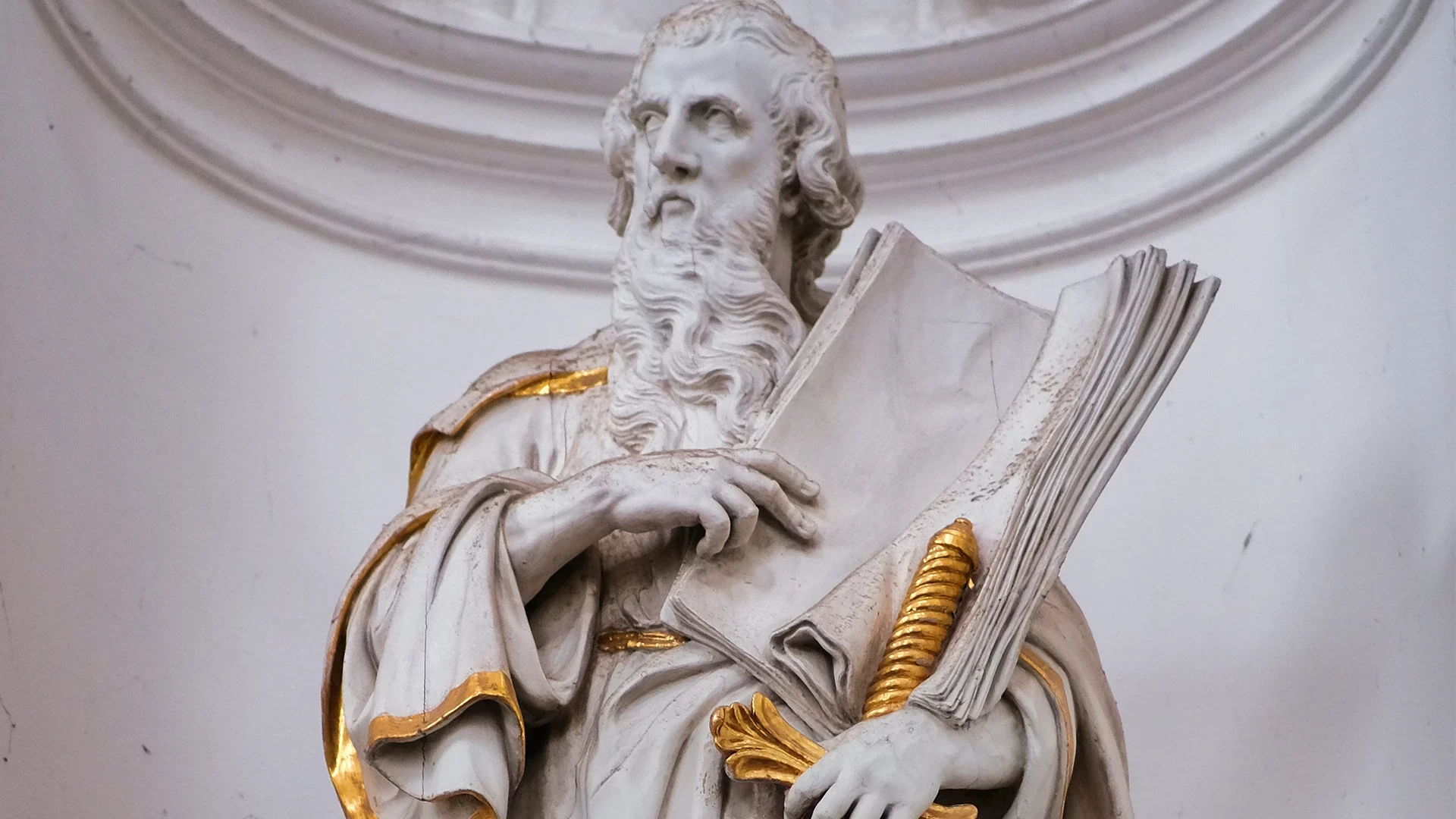Throughout the history of the Church, men and women rise to the occasion of exemplary holiness, and the Church holds up such children of God as models for holiness in our own lives as well as intercessors for our own needs as they number among the Church Triumphant in heaven. Specifically, a catechetical saint is such an individual who was devoted to teaching the faith in some capacity. It is to these saints that today’s catechists look for inspiration and intercession as the faith is tirelessly proclaimed to all men and women of goodwill. Among the number of catechetical saints, Saint Paul stands in the beginning among the original apostles as a “holy one” who, after a tremendous and sudden conversion, engaged in catechesis for the rest of his earthly life as he bore incredible hardships for the sake of his students. Therefore, St. Paul serves as a model for the catechist serving the parish catechumenal process. By looking to Paul, the catechist can grow in his/her formation in a truly authentic way.
St. Paul lived a life of profound holiness.
When writing to the Church in Philippi, he was able to express his personal hope that Christ be magnified in his own body, thus summing up the purpose of his earthly existence: “For to me life is Christ, and death is gain” (Phil 1:21). He understood that the life of the Christian is that of self-denial in order to allow the life of God to be manifest in one’s own person. We are able to see this attitude in St. Paul’s autobiography in miniature when he exclaims, “I have been crucified with Christ; it is no longer I who live, but Christ who lives in me; and the life I now live in the flesh I live by faith in the Son of God, who loved me and gave himself for me” (Gal 2:20). St. Paul endured numerous sufferings for the sake of the Gospel, thus walking along the path of the Via Dolorosa in imitation of Christ. For the sake of his Lord, St. Paul endured imprisonment, beatings, stoning, shipwrecks, dangers, hunger, thirst, and even exposure to the cold (2 Cor 11:23-27). By the end of his life, St. Paul was able to confidently state, “I have fought the good fight, I have finished the race, I have kept the faith” (2 Tim 4:7). St. Paul was so devoted to following the Lord that he even bore “the marks of Jesus” on his body (Gal 6:17). It is this marked sanctity of St. Paul, by the grace of God, which allows his name to be numbered among the canonized in the celestial court above.
When Pope Paul VI wrote, “Modern man listens more willingly to witnesses than to teachers, and if he does listen to teachers, it is because they are witnesses,” (Evangelii Nuntiandi 41) he may very well have had St. Paul in mind. Alongside the fact of deep personal witness by living a life of sanctity, St. Paul was numbered among the didaskaloi or “teachers” of the Christian faith in Antioch (Acts 13:1). This lifelong work and vocation of St. Paul is what makes him out to be a catechetical saint. After his extraordinary conversion on the path to Damascus and his subsequent personal healing and baptism, Paul spent a lifetime preaching the Gospel from the beginning of his first missionary journey in Cyprus to his own martyrdom for Jesus Christ just outside the walls of Rome. Appointed a “teacher of the Gentiles in faith and truth” (1 Tim 2:7), Paul devoted his time and energy to giving “sound instruction”, holding “firm to the sure word as taught” (Tit 1:9). His catechesis was evangelical, faithful, Christocentric, ecclesial, systematic and fully immersed in the word of God.
In his Apostolic Exhortation Catechesi Tradendae, Pope John Paul II reminds us that the specific aim of catechesis is twofold; Christian instruction should aim for understanding as well as conversion. Throughout the catechesis of St. Paul, we witness the constant endeavor to nourish the Christian life of each student so that they might be “changed by the working of grace into a new creature” (CT 20). This ultimate goal of Christian instruction is evident when we read of St. Paul’s paternal concern for his students: “My little children, with whom I am again in travail until Christ be formed in you” (Gal 4:19). The configuration of his students to the image of God in Jesus Christ through the power of the Holy Spirit is the perennial goal of St. Paul’s catechetical effort. So intertwined were catechesis and conversion in St. Paul’s mind that he felt no tension in speaking of knowledge as a primary instrument by which the Christian’s participation in the divine nature is renewed “after the image of its creator” (Col 3:10). He knew that the end of learning the mysteries of the Christian faith were ordered towards the personal response of faith, hope, and love. Paul describes the person with an understanding of all mysteries and knowledge as one reduced to nothing if such an individual is not converted to share in the divine life of love: “if I have prophetic powers, and understand all mysteries and all knowledge, and if I have all faith, so as to remove mountains, but have not love, I am nothing” (1 Cor 13:2).
Our Holy Father is adamant in reminding catechists that the “disciple of Christ has the right to receive the word of faith not in mutilated, falsified or diminished form but whole and entire, in all its rigour and vigor” (CT 30). The faith must be taught in its integrity, with no portion of the faith omitted for the sake of false sensitivity. We witness this faithful concern to pass on the deposit of faith as received in St. Paul’s teaching ministry. St. Paul exhorts his disciple, St. Timothy, with the strong command: “O Timothy, guard what has been entrusted to you” (1 Tim 6:20), and he urges his disciples in Thessalonica to stand firm and hold fast to the doctrine he has taught them, whether it has been taught “by word of mouth or by letter” (2 Thess 2:15). St. Paul admitted to the Galatians that the integrity of the Gospel was more important than his personal reputation, for the Gospel he preached was not his own possession (Gal 1:10). For St. Paul, the faith is like a treasure not his own, which has been entrusted to his care. He understood deeply that no gold coin within this treasure may be discarded or dirtied. Every last doctrine of the Christian deposit of faith must be guarded and transmitted, for it is God’s own personal revelation to humanity, a treasure worth guarding and sharing in its fullness.
The catechist’s teaching should be wholly Christocentric, having at its center and heart the person of Jesus Christ.
John Paul II explains that “everything else is taught with reference to him and it is Christ alone who teaches anyone else teaches to the extent that he is Christ’s spokesman” (CT 6). We discover a profound Christocentricity woven throughout St. Paul’s teaching, which reveals St. Paul’s understanding that Christians must be “taught in him, as the truth is in Jesus” (Eph 4:21). When St. Paul instructed the Corinthians on the doctrine of the Eucharist, he took care to note that his teaching was not his own but entirely that of the Master: “For I received from the Lord what I also delivered to you” (1 Cor 11:23). In the case of each particular doctrine, St. Paul taught the faith with reference to the central mystery of Christ. For example, when imparting instruction on Christian unity and humility, he makes reference to the selfless humility of God in the sublime event of the Incarnation (Phil 2:1-8). Instruction in Christian morality is imparted in view of the fact that the Christian is a member of the Body of Christ and the Christian’s body is now a temple of the Holy Spirit, purchased by the blood of Christ (1 Cor 6:15-20). Slaves are to be obedient to their masters as to Christ (Eph 6:5). Even Christian marriage is taught as a participation in the love of Christ’s mystical marriage with his Bride, the Church (Eph 5:21-33).
The Catechism of the Catholic Church affirms that the Church’s missionary task “must involve a process of inculturation if the Gospel is to take flesh in each people’s culture” (CCC 854). Accordingly, St. Paul understood that authentic catechesis always entails knowing one’s audience; in this way, he strove to become “all things to all men” so that he might “by all means save some” (1 Cor 9:22). For example, when St. Paul was escorted to the Greek city of Athens, he was profoundly disturbed at the sight of a city so full of pagan idols. In his ensuing monologue at the Areopagus, St. Paul appealed to the Greek world’s belief in divinity as responsible for the origin and existence of the universe. He lends sympathy with pagan religiosity, handling the subject of idol worship gently and even quotes two Greeks: Epimenides of Knossos (6th century B.C.) and Aratus of Soli (3rd century B.C.). Not surprisingly, this attempt at acculturating the Gospel message won several of the Greeks over, including Dionysius and Damaris (Acts 17:16-34). Another example of inculturation in St. Paul’s ministry may be seen when St. Paul circumcised St. Timothy “because of the Jews that were in those places” to which St. Paul was to travel (Acts 16:3). Paul knew that his message would be better received among the Jews if his traveling companion were circumcised, even though this sign of the Old Covenant was already previously determined to be unnecessary at the Council of Jerusalem.
Pope Paul VI, in Evangelii Nuntiandi, observes that the task of evangelization is “one that is deeply ecclesial” and therefore, “no evangelizer is the absolute master of his evangelizing action … he acts in communion with the Church and her pastors” (EN 60). St. Paul understood his mission in this ecclesial sense. Near the beginning of his ministry, St. Paul paid a visit to Jerusalem and consulted Peter for two weeks, and fourteen years later, he returned to Jerusalem once again to confirm the authenticity of his gospel by consulting, in private, those of repute (Galatians 1:18-2:2). Another fact that demonstrates the ecclesial nature of St. Paul’s evangelization is his love for the Church and recognition that it is the depository of truth. In his first epistle to St. Timothy, St. Paul refers to the household of God as “the church of the living God, the pillar and bulwark of the truth.” This strong and vibrant metaphor demonstrates St. Paul’s ecclesial mindset; the Church guards the truth, and the truth, in turn, brings unity among the children of God. St. Paul adamantly defends and exhorts the truth that there is “one body and one Spirit … one Lord, one faith, one baptism, one God and Father of us all” (Eph 4:4f). His work is not an individual enterprise fueled by a personal agenda but one born of love for Jesus Christ and his Immaculate Bride.
It should be noted that St. Paul’s catechesis was organic and systematic insofar as it initiated his “hearers into the fullness of Christian life” (CT 18). St. Paul imparted Christian doctrine according to the spiritual maturity of his audience. Thus, when writing to the church in Corinth, he explains himself by saying, “I fed you with milk, not solid food; for you were not ready for it; and even yet you are not ready, for you are still of the flesh” (1 Cor 3:2). A good catechist imparts instruction in a manner befitting the developmental stage of and the level of receptivity among the students so as not to inundate the Christian and in order to foster proper growth in the spiritual life. The catechumenate of the early Christian church, as witnessed to by the Early Church Fathers, took this approach, and even today we acknowledge this need to catechize progressively in the Rite of Christian Initiation for Adults. We may also look to the letter of St. Paul to the Romans to see for ourselves a prime example of his systematic instruction. Each successive section of this epistle builds off of the previous section as St. Paul presents Christian doctrine systematically. First, St. Paul demonstrates the universality of sin and its consequences. Second, the redemption Jesus Christ won for us is presented as God’s solution to the problem of sin. Third, justification is taught as achieved by the principle of faith as opposed to the ceremonial precepts of the Mosaic Law. Fourth, we are incorporated into this life of faith through the sacrament of baptism. Fifth, the doctrine of concupiscence is discussed in relation to sin. Finally, St. Paul gives a valuable instruction on redemptive suffering as the solution to concupiscence. From this one sample epistle, we have a survey of the systematic nature inherent within the catechetical activity of St. Paul.
The driving force of catechesis is the power of the word of God, and so the catechist must be immersed in Sacred Scripture, drawing strength from this divine wellspring.
St. Paul knew that his preaching had power because it was filled with the very word of God: “when you received the word of God which you heard from us, you accepted it not as the word of men but as what it really is, the word of God” (1 Thess 2:13). Throughout his epistles, St. Paul consistently quotes Old Testament Scripture passages and incorporates God’s Word into his writing through the use of literary allusion. In his catechesis on the Paschal Mystery, St. Paul affirms his profound knowledge of and need for the Christian proclamation to be grounded in Scripture when he teaches that “Christ died for our sins in accordance with the scriptures, that he was buried, that he was raised on the third day in accordance with the scriptures” (1 Cor 15:3). He emphasizes the value of Sacred Scripture in teaching, reproof, correction, and training in righteousness (2 Tim 3:16). St. Paul even refers to the Scriptures with the powerful metaphor of “the sword” in the task of spiritual warfare (Eph 6:17). This catechetical saint even authored a good portion of the Sacred Scriptures!
In the person of Saint Paul of Tarsus, the contemporary catechist is given a model of sanctity and catechesis. This saint was a convinced and faithful disciple of Christ and his Church, a true witness in his life to the doctrine he imparted. Simultaneously, we witness in St. Paul the qualities the twentieth century catechetical documents of the Magisterium are calling for. St. Paul’s catechesis aimed for conversion; it was faithful to the deposit of faith as received; it was centered on the person and work of Jesus Christ; it presented the word of God in all its rigour and vigor; it was ecclesial; it was imparted systematically and comprehensively; and it was entirely immersed in the word of God found both in the inspired Sacred Scriptures and the living Sacred Tradition.





